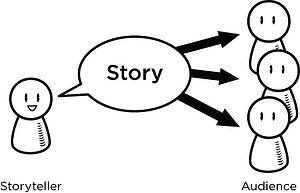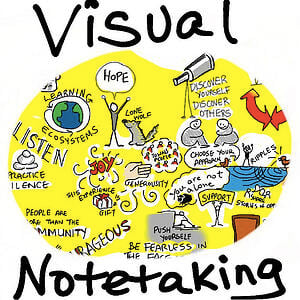Tell any good stories lately?
No? Well you may want to start.
Stories are more than fairy tales and happily ever-afters. As it turns out, they alter our brains and can even influence the way we think and act.
Here’s the psychology behind stories and how you can craft a story for your brand to engage customers and drive conversion rates.
The Psychology
Your brain is programmed to recognize sets of information (faces, letters, musical notes, etc) and assign each of them meaning (your mother’s face, the alphabet, the national anthem).
Stories are also recognizable patterns and, as humans, we use them to discover meaning in the world around us. Stories are so near and dear to us that we even invent them when they’re not actually there.
In 1944, university students in Massachusetts were shown a short film with two triangles and a circle moving across the screen. They were then asked to describe the scene. All except one described the movements with human narratives such as:
-
The two triangles (men) were fighting while the circle (a woman) was trying to escape
-
The big triangle felt “rage and frustration”
This study demonstrates our tendency to humanize abstract shapes and seek ourselves in the objects around us. This is called pareidolia, “the imagined perception of a pattern or meaning where it does not actually exist.” It’s what happens when we see shapes in clouds or a face in an electrical outlet.
Stories Create Sensory Experiences
Forget virtual reality. Our brains turn stories into perceived reality through senses.
When we consume uninteresting information, like a class lecture, our brains translate the words into meaning and that’s pretty much all that happens.
But when we hear a story, our brains change dramatically. If a savory meal makes an appearance in the story, your sensory cortex is activated helping you to smell and taste the meal. If the story involves a roller coaster or ride, your motor cortex gets involved. Your brain has the power to take stories and help you experience them as if they are real.
This means, you are the main character in every story you hear. And that’s brilliant, because it means you can tell your brand story with everyone in the audience being the hero when they listen.

Stories Influence Our Thought Patterns
When listening to impactful stories, the brain doesn’t just stop at experiences. Your brain can also cause you to develop opinions and thoughts aligned with the person telling the story. The brains of the storyteller and the listener can actually become synchronized says Princeton’s Uri Hasson
By telling a compelling story, you can alter the way your audience thinks and interacts with your brand.
How To Develop Your Story
So where do you start?
As marketers, our information is not usually put together in a visually appealing format for storytelling. We start with facts, which aren’t stories themselves, but they provide a great opportunity to develop storytelling. By adding context to your stats, you can reveal to your audience who you are and what you offer in a storyline.
How do we accomplish this? We R-E-A-D!
R - Research Target Audience
The single most important factor of telling your story has nothing to do with the story itself. It’s all about your target audience. You need to have a sense of who your prospective customers will be.
By interviewing individuals in your target audience (stay at home moms, college students, business professionals, CEOs, etc), you can get an idea of who they are, what they want, how they speak, and what they care about. Using this information, you can craft a story with which they might be able to empathize.
In a sense, you’re working backwards. Getting to know your target audience helps you get to know the main character of your story. After your research is done, you develop the actual storyline.
E - Establish A Story
After your research is complete, you need to create a story that corresponds to these findings. The hardest part is finding a balance of a story your company wants to tell with a story consumers want to hear.
The storytelling formula isn’t that complicated. Keep in mind the fact that the brain recognizes a story as a pattern. Here’s an easy formula for keeping all these elements in tact:
-
Your beginning should introduce a character with a problem that your product or service will help solve. That problem is the conflict
-
The middle should involve a character adopting your solution. This is the climax of the story
-
The ending should describe how the character benefits from that solution. This is the story’s resolution.
This formula is used in hundreds of stories and is by no means unique to marketing purposes. Take the fairy tale Snow White for example. The storyline follows this exact formula to a tee.
Why does it work so well? Because it’s more than an advertisement -- it’s like a movie trailer for your brand!
A - Add Details
Once you’ve got the framework solidified, it’s time to add the intricate details it needs for true authenticity and context. A story without personalized details fails to create context and will fail to make a connection. That’s why people are 14% more likely to interact with a personalized email, and they are 10% more likely to convert when they receive one.
Don’t miss the mark here. You have customers who align with your brand. Consider things they might enjoy that are non-related to your product or service, and how you can incorporate them into your story.
Consider Home Depot. Not necessarily part of a story, Home Depot does a great job of adding personalized details to its Twitter feed. Not only does the feed promote Home Depot deals and specials, it also promotes non-hardware related articles that are really successful with Home Depot’s clientele.
Why? Because customer’s who align with Home Depot also enjoy DIY projects, ideas, and contests. And Home Depot knows it. This makes Home Depot seem less like a corporate company, and more like a friend suggesting a product or service.
You can do this using the research you’ve gained off your customers. Do your customers care about a healthy lifestyle? Find a way to incorporate that into your story. This way you can create a story that advertises your brand the way you want while staying relevant to your customers. Sounds like a successful conversion formula to me.
D - Distribute
The last piece of the puzzle -- you have to get your story out. Just like a theatrical production needs an audience, your story needs a listener. Without someone to listen, your story is meaningless.
Thanks to the new digital age, there are numerous ways to distribute your content. And that means you are free to distribute material however you see fit. But how do you know which outlet is best for you? This goes back to your research stage. Conducting research early on shows where your target audience spends most of their time.
Maybe your target audience spends most of their time on Pinterest. Post your story where your audience members can most easily “stumble” upon it. The most logical and reliable place to post is your own website. Owned space is much more reliable than rented space (aka advertisements).
Stories are great marketing tactics because they are so universal. Everyone loves a good story because we are programmed to. Stories light up our minds and change our lives. If you tell your brand’s story accurately, it can improve your customers’ lives and your brand’s success all at the same time.



 BACK TO ARTICLES
BACK TO ARTICLES 

